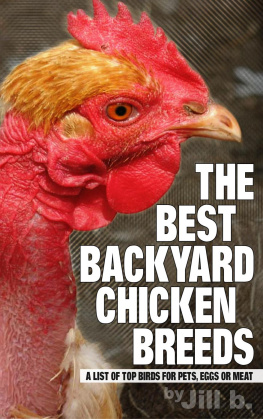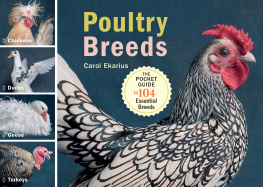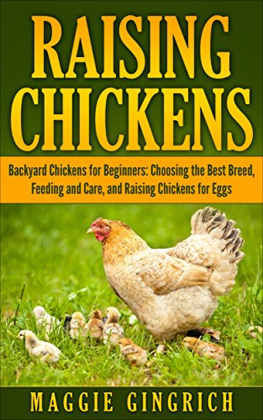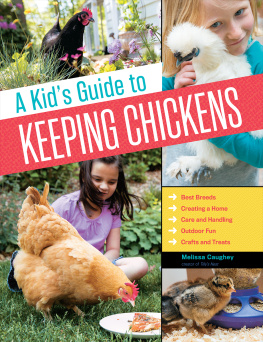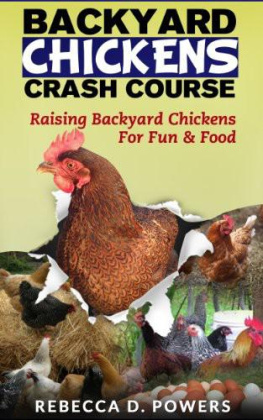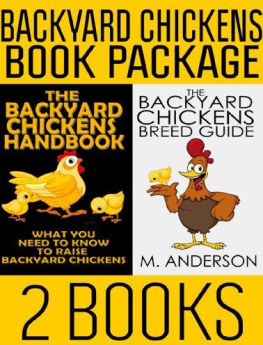The Best Backyard Chicken Breeds
A List of Top Birds For Pets, Eggs or Meat
By Jill b.
Copyright 2014
All Rights Reserved
Sign up for my newsletter and get THREE books for free :
HOW TO KEEP BACKYARD CHICKENS
CAN DOS & DONTS
THE MODERN AMERICAN FRUGAL HOUSEWIFE BOOK
Click here to get started: http://byjillb.com
Table of Contents
One Last Thing
How This Guide Can Help You
W hen I first embarked on my chicken-keeping adventures, I had no idea how many chicken breeds there were! I always thought a chicken was a chicken. There were white, black and brown chickens. That was it! It was only when we started looking to buy our first brood from mail-order catalogs that I discovered the fantastic range of chickens available: fluffy chickens, chickens with showgirl-looking heads of feathers, giant chickens, tiny chickens and even a chicken with a naked neck! This book is written to complement my book: How to Keep Backyard Chickens - A Straightforward Beginners Guide (http://byjillb.com).
Wikipedia lists the number of chicken breeds as being in the hundreds . The American Poultry Association shortens the list to over a hundred. Still, a hundred is a lot of chicken breeds to consider when you are just starting out. There is a lot of free information about chicken and chicken breeds. Unfortunately, a lot of published information is may not hold true for chickens that have been bred for showing rather than for their original traits. It takes a lot of time to wade through all that information. I know . Weve spent countless hours analyzing and weighing each breeds traits and how each particular breed might fit to our needs.
We have kept chickens since 2008. At its height, we had almost 90 chickens. We have kept about 25 different breeds. We live in a rural area but the traits that we were looking for in our chickens are similar to those who live in a more urban or suburban setting: we were looking for chickens with good egg production, docility and had the potential for meat production. Our first flock also included chickens that looked unusual.
When we are home, we let our chickens free-range during daylight hours. However, we also live in an area full of predators and the chickens have to be confined if we feel that it is not safe for them to free-range. Almost all the chickens confine themselves by choice during the long, cold Colorado winters.
This guidebook is a compilation of chicken breeds for a beginner chicken-keeping hobbyist to consider. I wrote it with the hope that it will help you save time and the expense of potentially choosing the wrong breed. The compilation is based on our research, our own experiences, as well as the experiences of other chicken keepers.

This photo includes all breeds that make our list of good breeds for the chicken hobbyist: Rhode Island Red, Black Jersey Giant and Bantam Buff Cochin. These chickens were docile enough to model our patent-pending invention - the Chicken Armor poultry saddle which helps protect chickens from over mating and during molting. For more information, please visit: http://chickenarmor.com
W hen referring to this guide, please remember that every chicken is an individual. While chickens from any particular breed should exhibit traits of that breed, how strongly that trait manifests itself will depend on the chicken. In some cases, our sample size is extremely small - one - so keep this in mind when we draw our conclusions about a breed. Your experience may be very different from ours!
Finally, remember that chickens are social creatures. Even if I classify a breed as a good pet breed, you will need to have at least two chickens to keep some form of social order in place for them. Ideally you should have at least four chickens to account for possible death or the possibility of you having to get rid of an unexpected rooster.
D ual purpose - Chickens having two purposes: meat and egg production.
Egg color - Chickens can lay a variety of egg colors ranging from the common white and light brown to blue to olive green to turquoise to dark chocolate brown. The egg shell color does not affect the taste nor the nutritional value of the egg itself.
General purpose - Chickens that have more than one use.
Heavy breed - Stout, meaty chickens. These chickens usually do better in cold climates.
Layers - Chickens raised for egg production rather than for meat.
Meat bird - Chickens raised for meat rather than egg production.
Ornamental - Chickens bred for exhibition.
The Two Groups: Standards and Bantams
C hickens can first be broken down into two groups: Standards, which are your regular-sized chickens or Bantams, sometimes referred to as Bantys, which are actually separate breeds. Bantams are usually a fourth or a fifth the size of a standard-sized chicken, if there is a standard-sized equivalent to that particular breed.
True Bantams are chickens that are naturally small and that do not have a larger counterpart. An example of a True Bantam is the Japanese Bantam ( Chabo ), a breed which I do not recommend. We had a Chabo rooster that while beautiful, was very aggressive despite its punitive size.
Bantam chickens are believed to have originated from Asia, particularly from the city of Bantam (currently known as Banten Province), which was once a major seaport in Indonesia. In Indonesia, they are referred to Ayam Katek. My knowledge of Indonesian/Malay is rudimentary but Ayam means chicken and Katek roughly translates to mean short or midget. Compared to their Standard counterparts, Bantams have disproportionately larger feathers, heads, wings and tails in comparison to their weight.
Bantams have become increasingly popular with chicken keepers. Their size not only makes them more suitable for small spaces, breeds such as Silkies, Seabrights, Japanese and Dutch often come in unusual colors or patterns, which makes them more exotic-looking. Bantams eat the same kinds of food as Standards, and can produce as many eggs, albeit smaller ones (about half to a third the size of standard eggs).
Next page
